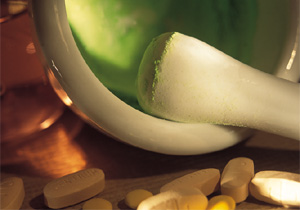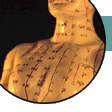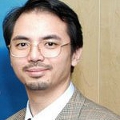Kidneys
The main physiological functions and indicators of the
kidneys are:
(1) storing essence, controlling human reproduction, growth and development;
(2) controlling water metabolism;
(3) receiving qi;
(4) producing marrow, filling up the brain, controlling the bones,
manufacturing blood and influencing hair luster;
(5) opening into the ear, perineal ante-tract and perineal post-tract;
(6) connects with the urinary bladder to which it is connected from
the exterior and the interior.
Storing Essence, Controlling Human Reproduction Growth and Development
Essence is defined as the basic substance both constituting the human
body and maintaining its functional activities. As described in the
Suwen, "Essence is the foundation of the human body." Essence consists of
two parts: congenital essence inherited from the parents and acquired
essence transformed from food.
Essence is stored in the kidney and is known as kidney qi.
It greatly influences the ability of reproduction, growth, and development.
According to the Suwen:
At the age of fourteen, a woman will begin to menstruate. Her ren
channel becomes unobstructed, and the qi of her chong channel is replete.
This is why her menstruation becomes regular and she is able to
conceive.... At the age of forty- nine, a woman's ren channel becomes
deficient, the qi of the chong channel becomes weakened and scanty, sexual
energy becomes exhausted, and menstruation stops with the result that her
body becomes old and she is no longer able to conceive.
In reference to men, it continues:
"As to a man.... At the age of sixteen, his kidney qi becomes even more
abundant, he begins to have sexual energy and is full of semen that
he can ejaculate. When he has sexual intercourse with a woman, he
can cause conception.... At the age of fifty-six the liver qi begins
to weaken, the tendons become inactive, sexual energy begins to run out,
the semen becomes inadequate, the kidney becomes debilitated with the
result that all parts of the body begin to grow old. At the age of sixty-four
his hair and teeth are gone."
Thus, according to traditional Chinese medicine, kidney qi plays an
essential role in the function of reproduction, growth, and development.
If this function is abnormal, infertility, infantile underdevelopment,
maldevelopment, weakness of bone development, etc. will manifest.
Kidney essence is classified as yin, while qi is yang. Known as kidney yin
and yang, they both restrict and depend on each other in order to maintain
a dynamic physiological balance. If this balance is disrupted, pathological
changes of hyperactivity or hypoactivity of kidney yin and yang will occur.
Clinically, a kidney yin deficiency may be manifested soreness,
aching and weakness of the lumbar region and knees, blurred vision,
poor memory, etc. A yin deficiency leading to blurred vision,
poor memory, etc. A yin deficiency leading to yang preponderance will
produce tidal fever, night sweating, dizziness, ringing in the
ear (tinnitus), spermatorrhea, and sexual dreams. Kidney yang deficiency
decreases the warming function of the kidney bringing on the
symptoms of lassitude, coldness and pain in the lumbar region and the
knees, cold extremities and frequent urination, leading to pathological
conditions such as inadequate reproductive ability, impotence, premature
ejaculation and coldness of the uterus. If a certain degree of kidney
yin or yang deficiency is reached then either may injure the other resulting
in a loss of the body's dynamic physiological balance.
In addition, clinical manifestations such as frequent and clear
urination, enuresis, incontinence of urine, spermatorrhea, premature
ejaculation, etc. which show no heat or cold syndromes are considered
to be a kidney qi deficiency. The clinical symptoms of dizziness,
ringing in the ears, soreness and aching of the lumbar or knee region,
infantile maldevelopment, etc, which demonstrate no clear cold or heat
symptoms, are classified as kidney-essence deficiency.
Controlling Water Metabolism
The kidney plays an essential role in the distribution, regulation,
and metabolism of water. As the Suwen says, "The kidney is the organ
of water in charge of fluid." Water is received by the stomach,
transformed and transported by the spleen. Par of the fluid
is sent down by the descending function of the lung until it
finally reaches the kidney and is divided by the qi activity of
the kidney yang into two parts: clear and turbid. The useful
clear fluid is sent back up to the lung a jin, and the turbid
waste fluid flows down into the urinary bladder to form urine,
which is excreted. The distribution of water is related to the
functions of the stomach, spleen, small intestine, large intestine,
lung, urinary bladder, and sanjiao, but they all rely on the warming
and pushing function of kidney yang. If kidney yang is insufficient,
this may lead to retention of water resulting in scanty urination,
retention of urine or frequent urination, enuresis, etc.
Receiving Qi
The reception of qi is controlled by the kidney, which leads it downward
from the lung. If kidney qi is adequate, and its functioning normal,
then breathing is even and smooth. In a deficient state, uneven breathing,
dyspnea, and asthma exacerbated by exercise will occur.
Controlling Bone, Producing Marrow, and Influencing Hair Luster
Nourishment of the bone structure requires marrow, a product of
kidney essence. The term "marrow" includes the bone marrow and
the spinal cord. The brain is known as the "sea of marrow."
Sufficiency of this essence produces a well developed and
functioning skeletal system. Inadequate essence, however, may lead
to a variety of syndromes: a sore, aching, and weak lumbar region
and knees, weakness or atrophy of the lower limbs, infantile maldevelopment,
delayed closing of the fontanelle, etc. Furthermore, according
to traditional Chinese medicine, "teeth are the remainder of bone."
Poor nourishment by kidney essence also caused looseness and loss of teeth.
Essence and blood generate each other. Ample essence makes sufficient blood.
Hair is nourished by the blood and rooted on the basis of kidney qi.
Therefore luster, moisture, dryness, roughness growth and falling out
of hair is related to the sufficiency of kidney essence. As the Suwen says,
"The kidney is in tune with the bones, its prosperity is reflected
in the luster and moisture of the head hair."
Opening into the Ear, Perineal Ante-tract and Perineal Post-Tract
Auditory function is dependent on nourishment from the essential qi
of the kidney. If that essence is sufficient, then keen hearing will
result. Otherwise, there will be deafness and a ringing in the ears.
The perineal ante-tract (including urethra and vagina) and post-tract (anus)
have the action of reproduction and excretion through the function
of kidney qi. Insufficiency will manifest as frequent urination, enuresis
or scanty urine; for the reproductive organs there will be spermatorrhea,
impotence, premature ejaculation, or infertility; bowel movements will be
subject to either morning diarrhea or constipation.
Uterus
The uterine function is menstruation and foetal nourishment. It has a close
relationship with the kidney, and the chong and ren channels. Normal
menstruation reproductive ability and optimum foetal mourishment follow
sufficiency of qi and blood in the chong and ren channels. If their
function is weak, then irregular menstruation, amenorrhea, and infertility
will appear.
Related Subjects
Read more on other Zang Organs: Heart,
Lung,
Spleen, and
Liver.
|

 This website is published, edited and designed by Raymond Cheng,
and reflects only and only his personal views and opinions in his individual capacity.
The information available at this website is not intended
directly or by implication to either diagnose or treat any
medical, emotional, or psychological condition or disorder.
It is also not intended to create a physician-patient relationship
between you and I or between you and Wyith Institute™ and The Office of Dr Raymond K K Cheng.
The information here is not a substitute for advice and treatment provided
by your physician or by another healthcare professional.
It is always recommended that consultation with local healthcare providers
be obtained for any of your specific health or medical concerns.
Furthermore, any products that can be purchased (yet you can see I don't have much
to sell here) through advertisers' banners or through links to other websites
are not either explicitly or implicitly given any warranty or endorsement
by me, my colleagues, Wyith Institute™ or any of its associated businesses.
This website is published, edited and designed by Raymond Cheng,
and reflects only and only his personal views and opinions in his individual capacity.
The information available at this website is not intended
directly or by implication to either diagnose or treat any
medical, emotional, or psychological condition or disorder.
It is also not intended to create a physician-patient relationship
between you and I or between you and Wyith Institute™ and The Office of Dr Raymond K K Cheng.
The information here is not a substitute for advice and treatment provided
by your physician or by another healthcare professional.
It is always recommended that consultation with local healthcare providers
be obtained for any of your specific health or medical concerns.
Furthermore, any products that can be purchased (yet you can see I don't have much
to sell here) through advertisers' banners or through links to other websites
are not either explicitly or implicitly given any warranty or endorsement
by me, my colleagues, Wyith Institute™ or any of its associated businesses.



 Thank you for visiting this TCM and acupuncture information website.
If you have previously been to this website, you might have
noticed that some of the pages on ancient historical ideas and
holistic thinkings related to Chinese metaphysics are temporarily taken offline.
This is because I will be revamping the whole website and be moving
those information into a new \"Ancient Chinese Culture\" section
so as to reflect a more current perspective on the interpretation
of some of the fundamental concepts as well as to include
some of the latest information in the area.
But if you have just found this website for the very first time, I welcome you again and
wish you could find what you require and, hopefully, you could also be benefitted
from reading the articles I published on this website.
Thank you for visiting this TCM and acupuncture information website.
If you have previously been to this website, you might have
noticed that some of the pages on ancient historical ideas and
holistic thinkings related to Chinese metaphysics are temporarily taken offline.
This is because I will be revamping the whole website and be moving
those information into a new \"Ancient Chinese Culture\" section
so as to reflect a more current perspective on the interpretation
of some of the fundamental concepts as well as to include
some of the latest information in the area.
But if you have just found this website for the very first time, I welcome you again and
wish you could find what you require and, hopefully, you could also be benefitted
from reading the articles I published on this website.